
Evaporation and Evapotranspiration
A.J. Erickson, J.S. Gulliver, R.M. Hozalski, O. Mohseni, J.L. Nieber, B.N. Wilson, P.T. Weiss
Evaporation (transformation of liquid water to water vapor) and transpiration (water vapor emission from plant surfaces) are outflow processes of water budgets. Evapotranspiration (ET) is the combined process of water surface evaporation, soil moisture evaporation, and plant transpiration. Stormwater management applications may include water surfaces (e.g., pond, wetland, etc.), vegetation, or both, and therefore may require an estimation of evaporation, transpiration, or both to estimate water level changes between storms. For example, a wetland system includes vegetation, open water surfaces, and exposed moist soils. The combined effects of water surface evaporation, soil moisture evaporation, and plant transpiration for this system are often significant components of annual water budgets. Evaporation tends to lower water level in a pond or wetland over time, and evapotranspiration acts to dry out the soil before the next storm. During storms, however, evaporation and evapotransporation are typically not significant compared to precipitation, discharge and infiltration, and are often not considered.
Evapotranspiration is a function of meteorological conditions, such as air temperature, wind speed, relative humidity, and solar radiation; and of evaporating/transpiring surface conditions, such as albedo (i.e., fraction of reflected incident sunlight), water temperature, roughness, and water availability. The effective surface conditions of plants are especially complex. Stomata openings in plant leaves are essential for the movement of water vapor and other gases. The number of these openings varies with plant type. The size of these openings varies with changes to the pressure in plant cells resulting from water stress and other factors. Often the complexity of plant canopies is simplified by considering only potential evapotranspiration. Potential ET occurs when the water availability in the soil does not influence ET. Therefore, the complexity associated with water stress is not needed to determine ET. Water stress can be minimized by irrigation systems. Reference plant ET is used to further simplify the determination of ET. (Reference plant ET is the potential ET for a standard reference plant.) The two most widely used reference plants are alfalfa and grass. Reference plant ET allows the impact of meteorological variables to be assessed using relatively constant plant conditions. Complexities related to time-varying vegetal cover and water stress do not need to be considered. The conversion of reference plant ET to potential ET for different plant types is done using plant or crop factors.
The average annual ET for a watershed is often estimated using a water balance, which can be described by equation 4.10. The change in storage increases and decreases during the year; for many years, however, the net change is generally small. Therefore, for average annual ET, ΔS ≈ 0, and typically DS ≈ 0, and equation 4.10 can be simplified to equation 4.11, which indicates that the average annual ET is equal to the difference between the average annual precipitation and average annual runoff depth. The Minnesota Department of Natural Resources publishes maps that allow the average annual precipitation depth and average annual runoff depth to be estimated for any location in Minnesota. Example 4.6 is an illustration of the use of equation 4.11.
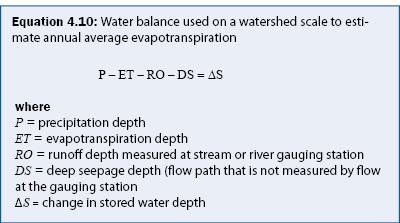
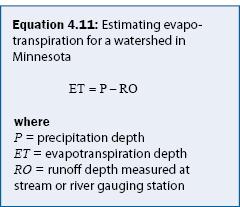
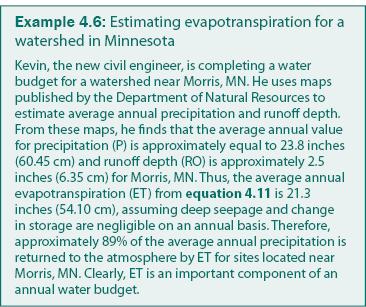
Eddy correlation techniques have been developed to measure ET directly (Kizer and Elliot 1991). In contrast to annual ET values, these measurements can be used to estimate ET during small time intervals (hourly or less). High speed sensors are placed over the plant canopy or water body. These sensors typically measure simultaneously vertical velocities and absolute humidity values. The product of these two measurements corresponds to the rate of water vapor movement as the result of (mostly) ET processes. Important considerations in using this approach are the frequency response of the sensor, instrument height, and separation distance between sensors. The sensors must be placed carefully to capture the overall movement of water vapor that are transported by turbulent eddies of different sizes. Although eddy-correlation techniques are theoretically appealing, care is needed in setting up eddy-correlation instruments and analyzing their data. They are only recommended for use by professionals with experience in measuring turbulent flows.
Direct measurement of ET by eddy correlation methods is difficult, and therefore estimates are usually obtained indirectly from measured meteorological or other variables. Energy balances provide a useful theoretical framework for converting the indirect measurements into ET estimates. Key energy terms are net radiation, sensible heat loss, and latent heat of ET. The daily energy balance for plant canopies and water bodies can be written as equation 4.12, in which all energy terms have units of energy per unit area per day.
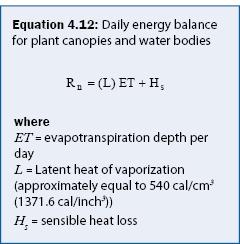
Net radiation includes incoming and outgoing short-wave and long-wave radiation. Although sensors are available to measure net radiation directly, observed short-wave radiation is more readily available. Jensen et al. (1990) provides a good discussion of approaches that can be used to compute net radiation from short-wave and other meteorological information. (L)ET is the energy used to evaporate the water corresponding to ET. The sensible heat loss is the energy loss by the temperature differences between the evaporating surface and the atmosphere. For plant canopies, an additional energy term for the movement of heat into the soil is sometimes included in equation 4.12. Typically heat moves from the canopy into the soil during the daylight hours and from the soil to the canopy at night. Net sensible heat loss to the soil for a day-night cycle is often negligible.
The Bowen ratio (β) is defined as the ratio of sensible to latent heat terms (i.e., β = Hs/(L) ET). Instrumentation systems have been designed to measure the Bowen ratio (Heilman et al. 1996). From measured Bowen ratio and net radiation, ET is defined directly as given in equation 4.13. Instruments to measure Bowen ratios require technical skills to be used effectively. This method is only recommended for professionals with considerable experience in designing and collecting experimental data.
The Penman and Penman-Monteith methods are widely used to estimate ET from meteorological variables. Both methods are based on the energy balance given by equation 4.13. The evaluation of the parameters for these methods is done using potential ET or, more commonly, using reference plant ET. For reference plants, ET can be estimated from measured (or estimated) net radiation, maximum and minimum air temperatures, maximum and minimum relative humidity, and wind speed. The reader is referred to Jensen et al. (1990) for more information. Adjustments in the reference plant ET to actual ET are necessary. The Penman method can also be used to compute evaporation from water bodies.
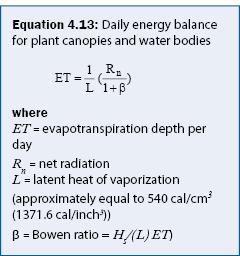
Pan evaporation techniques are widely used throughout the United States to measure evaporation from water surfaces and ET from plant canopies (Farnsworth and Thompson 1982, Jensen et al. 1990). With these techniques, pans are filled with water and are placed on or near the water body or within the standard plant canopy conditions. Evaporation rates from the pan are measured and used to estimate evaporation or reference plant ET. Pan evaporation rates are typically greater than actual lake evaporation and reference plant ET rates. Therefore, an adjustment factor, called a pan coefficient, is used and typically ranges between 0.64 and 0.81, as shown in equation 4.14. For Minnesota, total pan evaporation rates from 1974 to 2004 (April–October) averaged 36.98 inches (93.9 cm) with a standard deviation of 4.71 inches (11.96 cm) as reported in St. Paul, Minnesota, by University of Minnesota researchers (University of Minnesota 2005). Example 4.7 demonstrates how this information can be used to estimate evaporation with equation 4.14.
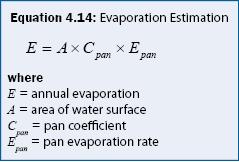
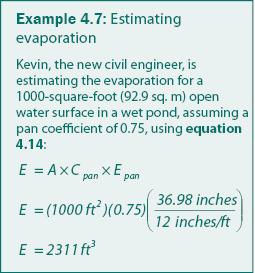
Actual ET can be substantially different than potential ET because of limited depth of available water in the soil. Conversion to actual ET requires a measurement or prediction of the soil moisture. The fraction of available water (FAW) is defined as the ratio of the difference between site moisture content and wilting point to the difference of field capacity and wilting point. When this fraction is greater than 0.6, then the impact of available water is minor and actual ET is well approximated by potential ET. When the fraction is less than 0.6 the actual ET can be reduced linearly, as a rough approximation, with FAW to a value near zero at FAW = 0 (Larson 1985).
Evapotranspiration can affect the concentration of most pollutants of concern in stormwater management. Most pollutants (e.g., phosphorus, chloride, solids)do not evaporate and will become more concentrated as water evaporates from an open surface or from the soil. It is important to consider ET as a water-budget outflow, where necessary, to avoid miscalculations in the pollutant load budget when using concentration measurements.
Recommendations
Evapotranspiration may be a significant water budget component for wetlands, wet ponds, and other stormwater treatment practices that are designed to maintain a permanent pool or have large areas of moisture-rich soils, and therefore should be estimated or considered. ET processes typically have a minimal affect on the performance of stormwater best management practices that are designed to treat water within a short period of time (less than 4 days) and therefore the estimation of ET is typically unnecessary for the assessment of performance of these practices.
Evapotranspiration can be estimated using indirect (e.g., abstraction in simplified water budgets) or direct methods (e.g., Eddy correlation or daily energy balance, equation 4.13). It is recommended that indirect methods of estimation be used in most cases, but direct methods should be used when more accurate measurements of evaporation or ET are necessary.
Continue to Rainfall
